
Regularly reviewing these reports what is a death spiral definition meaning example helps ensure that all outstanding invoices are accounted for and that no unpaid debts have gone missing. Some commonly used AR metrics by businesses are DSP, collection effectiveness index (CEI), and average days delinquent (ADD). Whenever a customer delays in paying invoicing, a business faces a lot of cash flow and liquidity problems, resulting in financial issues and working capital shortages.
Current asset less current liabilities equals working capital, and every business needs to generate enough in current assets to pay current liabilities. With accounting software like QuickBooks, you can access an aging report for accounts receivable in just a few clicks. You’ll want to monitor this report and implement a collections process for emailing and calling clients who fall behind. When a company owes debts to its suppliers or other parties, those are accounts payable.
Streamline AR Processes with Accounts Receivable Management Software
When you sell goods on credit, your customers owe money to you, so you act as a creditor to your customers. This credit sale is then recorded as accounts receivable in your books of accounts. The goal is to increase the numerator (credit sales), while minimising the denominator (accounts receivable).
A high CEI rating indicates that a business’s Accounts Receivable process is effective in collecting customer payments. Cash reconciliation, or effective record-keeping, is important for generating accurate financial records and ensuring all payments are resolved. Promptly recording all transactions makes it easier to track any unpaid invoices and keep all financial records up to date. Clear billing procedures are an essential component of effective accounts receivable management.
Receive payments 4x faster
However, the benefits go beyond materializing sales and improving cash flows. Day Sales Outstanding, or DSO, measures the time it takes your Accounts Receivable team to collect an invoice payment. It’s a valuable indicator for assessing the efficiency of your collections process and the credibility of your customers.

Accounting 101 for Small Businesses
It’s an asset because it has value, and it’s a current asset because it’s expected to be collected within the next 12 months. Net receivables is an accounting term for a company’s accounts receivable minus any receivables it has reason to believe it will never collect. It is typically expressed as a percentage of uncollectible debts relative to collectible ones, and the lower the percentage, the better. A receivable is created any time money is owed to a business for services rendered or products provided that have not yet been paid for. For example, when a business buys office supplies, and doesn’t pay in advance or on delivery, the money it owes becomes a receivable until it’s been received by the seller. Further analysis would include assessing days sales outstanding (DSO), which measures the average number of days that it takes a company to collect payments after a sale has been made.
- You’d have $1,000 in accounts payable on your balance sheet for the invoice.
- The customers who may not pay for the goods sold to them are then recorded as bad debts in the books of accounts.
- Once you receive payment, you can reconcile your accounts to ensure there are no discrepancies, and then close paid transactions.
- Current asset less current liabilities equals working capital, and every business needs to generate enough in current assets to pay current liabilities.
Risk of Bad Debts
Accounts receivable are an important element in fundamental analysis, cost of equity vs cost of capital a common method investors use to determine the value of a company and its securities. Because accounts receivable is a current asset, it contributes to a company’s liquidity or ability to cover short-term obligations without additional cash flows. Accounts receivable, or receivables, can be considered a line of credit extended by a company and normally have terms that require payments be made within a certain period of time.
If the balance is going down, that means you’re collecting customer payments from previous invoices. They are considered liquid assets because they can be used as collateral to secure a loan to help the company meet its short-term obligations. Accounts receivable (AR) is an accounting term for money owed to a business for goods or services that it has delivered but not been paid for yet. Accounts receivable is listed on the company’s balance sheet as a current asset. One of the most important and urgent steps to streamline receivables management is to automate the process. Accounts Receivable Open, or AR Open, measures how many ongoing Accounts Receivable a business has in a given period.
There are a few big advantages to managing your accounts receivable effectively. For one, it can help you optimize your cash flow and increase your working capital. Automating your accounts receivable can also help reduce the administrative burden of managing it, such as sending automated reminders, invoicing, and tracking payments. If your role of financial management in law firm success accounts receivable balance is going up, that means you’re invoicing more.
It’s essential for managing a smooth transition from sales to revenue and ensuring that a business maintains a healthy cash flow. Note that regular reconciliation of payments with outstanding invoices can help identify any discrepancies or overdue accounts. Bad debt can also result from a customer going bankrupt and being financially incapable of paying back their debts. One way to get people to pay you sooner is to make it worth their while. Offering them a discount for paying their invoices early—2% off if you pay within 15 days, for example—can get you paid faster and decrease your customer’s costs. If you don’t already charge a late fee for past due payments, it may be time to consider adding one.
